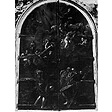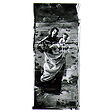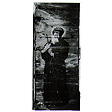
The Reliquary
in the parrochial church
of Fuendetodos (Zaragoza)







 |
The first known work by Goya was painted sometime between 1760 and 1767, is on the doors and surroundings of a cupboard for the storing of holy relics in the church at Fuendetodos, the vilage of his birth. The reliquary was destroyed in the Spanish Civil War (1936-39), and all that remains of it are black and white photographs.
The reliquary was sunk into the wall and had wooden doors. On these doors and the surrounding plaster Goya painted a surrounding trick of perspective and framed the principal scene with a baldachin supported by angels. The closed doors of the reliquary are a representation of what is beyond doubt the principal cult in Aragon; that of the Virgen del Pilar: the Apparition of the Virgin of the Pillar in Zaragoza. According to secular tradition, the Virgin Mary visited St. James the Apostle, who was at the time near the river Ebro in Zaragoza. St. James was dispirited by the hard-heartedness of the Spaniards. Mary gave him encouragement and left a column on which she had stood to speak to him. The tradition, attested to from the 13th century is a distinctive feature of Aragonese and Zaragoza Catholicism. The Pilar, a column of veined marble, is venerated in the Basilica del Pilar, where Goya painted the choir ceiling opposite to the Virgin (the Coreto) and one of the cupolas (Regina Martyrum). Goya felt great devotion for the Virgen del Pilar, as can be seen in his work and his private letters. His family felt the same devotion and Goya painted a small picture of the Virgin which today can be found in the Museo de Zaragoza. The iconography of the principal theme can best be described by the literary description written by canon J.F. de Amada in 1680: 'the angels brought with them a small column of veined marble or jasper, and from a different material they had formed an image, of no great size, of the Queen of Heaven. This the angels carried with great veneration, and all had been prepared that night, by the powers of these divine spirit who had created and worked on this wondrous object. The image was shown unto St. James from the cloud of the Queen of Heaven, where it was surrounded by Heavenly Choirs, all shining with great refulgence and beauty, although none could compare in any way to the Holy Virgin herself.' On the inside of the doors Goya painted The Virgin of Mount Carmel and St. Francis of Paula. Javier García Marco BibliographyCompendio de los Milagros de Nuestra Señora del Pilar de Zaragoza / Don Joseph Félix de Amada, canónigo de la Santa Iglesia Metropolitana de Zaragoza. Zaragoza : Agustín Verges, 1680. |
|
| Baldachin supported by angels |  |
|
| Apparition of the Virgin of the Pillar to Santiago |  |
|
| The Virgin of Mount Carmel |  |
|
| St. Francis of Paula |
 |
InfoGoya 96 is an initiative of the University of Zaragoza, sponsored by the Institution Fernando el Católico of the Deputation of Zaragoza on an Apple Internet Server donated by Apple Computer. |    |